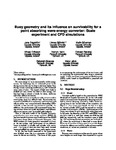Buoy geometry and its influence on survivability for a point absorbing wave energy converter: Scale experiment and CFD simulations
| dc.contributor.author | Engström, J | |
| dc.contributor.author | Sjökvist, L | |
| dc.contributor.author | Göteman, M | |
| dc.contributor.author | Eriksson, M | |
| dc.contributor.author | Hann, Martyn | |
| dc.contributor.author | Ransley, E | |
| dc.contributor.author | Greaves, Deborah | |
| dc.contributor.author | Leijon, M | |
| dc.date.accessioned | 2019-04-04T09:41:00Z | |
| dc.date.available | 2019-04-04T09:41:00Z | |
| dc.date.issued | 2017 | |
| dc.identifier.uri | http://hdl.handle.net/10026.1/13620 | |
| dc.description.abstract |
For wave energy to be an economically viable energy source, the technology has to withstand power levels during storms that can be close to 50 times higher than during normal operating conditions [1], and withstand many years of wear. The impact of high wave loads is studied not only within the field of wave energy, but has long been a subject of study for ships, platforms and other offshore structures. To model the force on the device under extreme and/or overtopping waves is a difficult task. Experiments are expensive and difficult to implement, and numerical methods are either very computationally demanding CFDmethods, or less accurate approximative methods. In addition, the performance and experienced forces during extreme waves are model dependent, and different offshore structures must be studied independently. Here, a 1:20 scale model of the Uppsala University point-absorber type wave energy converter (WEC) [2] has been tested in extreme wave conditions at the COAST Laboratory Ocean Basin at Plymouth University. The WEC consists of a linear generator connected to a buoy at the sea surface, and performance of two different buoys is studied: a cylinder and cylinder with moonpool. Two types of wave sets have been used: focused waves embedded into regular waves, and irregular waves. In [3], the line forces measured in the experiment were studied, since this is a parameter of high relevance for device survivability. The focus of this paper is on comparing the performance of the two buoys, and on analysing the experimental data using a numerical model. A fully non-linear computational fluid dynamics (CFD) model based on OpenFOAM is presented and validated. | |
| dc.language.iso | en | |
| dc.title | Buoy geometry and its influence on survivability for a point absorbing wave energy converter: Scale experiment and CFD simulations | |
| dc.type | conference | |
| dc.type | inproceedings | |
| plymouth.date-start | 2017-05-01 | |
| plymouth.date-finish | 2017-05-03 | |
| plymouth.conference-name | 5th Marine Energy Technology Symposium (METS) | |
| plymouth.organisational-group | /Plymouth | |
| plymouth.organisational-group | /Plymouth/Faculty of Science and Engineering | |
| plymouth.organisational-group | /Plymouth/PRIMaRE Publications | |
| plymouth.organisational-group | /Plymouth/REF 2021 Researchers by UoA | |
| plymouth.organisational-group | /Plymouth/REF 2021 Researchers by UoA/UoA12 Engineering | |
| plymouth.organisational-group | /Plymouth/Research Groups | |
| plymouth.organisational-group | /Plymouth/Research Groups/Marine Institute | |
| plymouth.organisational-group | /Plymouth/Users by role | |
| plymouth.organisational-group | /Plymouth/Users by role/Academics | |
| plymouth.organisational-group | /Plymouth/Users by role/Researchers in ResearchFish submission | |
| dc.publisher.place | Washington, D. C., USA | |
| dcterms.dateAccepted | 2017-01-01 | |
| dc.rights.embargoperiod | Not known | |
| rioxxterms.licenseref.uri | http://www.rioxx.net/licenses/all-rights-reserved | |
| rioxxterms.type | Conference Paper/Proceeding/Abstract |


